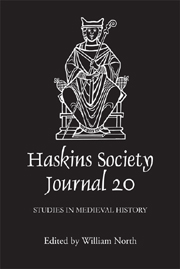Book contents
- Frontmatter
- Contents
- Editor's Note
- Abbreviations
- 1 Buckets, Monasteries, and Crannógs: Material Culture and the Rewriting of Early Medieval British History
- 2 Punishing Bodies and Saving Souls: Capital and Corporal Punishment in Late Anglo-Saxon England
- 3 Writing Latin History for a Lay Audience c. 1000: Dudo of Saint Quentin at the Norman Court
- 4 Between Neighbors and Saints: Waleran I of Meulan and the Allegiance of Lesser Lords in the Eleventh Century
- 5 Who Founded Durtal? Reconsidering the Evidence
- 6 Robert Curthose: Ineffectual Duke or Victim of Spin
- 7 The Chivalric Transformation and the Origins of Tournament as seen through Norman Chroniclers
- 8 An Internal Frontier? The Relationship between Mainland Southern Italy and Sicily in the ‘Norman’ Kingdom
- 9 ‘Hywel in the World’
- 10 Prices, Price Controls, and Market Forces in England under Edward I c. 1294–1307
6 - Robert Curthose: Ineffectual Duke or Victim of Spin
Published online by Cambridge University Press: 12 September 2012
- Frontmatter
- Contents
- Editor's Note
- Abbreviations
- 1 Buckets, Monasteries, and Crannógs: Material Culture and the Rewriting of Early Medieval British History
- 2 Punishing Bodies and Saving Souls: Capital and Corporal Punishment in Late Anglo-Saxon England
- 3 Writing Latin History for a Lay Audience c. 1000: Dudo of Saint Quentin at the Norman Court
- 4 Between Neighbors and Saints: Waleran I of Meulan and the Allegiance of Lesser Lords in the Eleventh Century
- 5 Who Founded Durtal? Reconsidering the Evidence
- 6 Robert Curthose: Ineffectual Duke or Victim of Spin
- 7 The Chivalric Transformation and the Origins of Tournament as seen through Norman Chroniclers
- 8 An Internal Frontier? The Relationship between Mainland Southern Italy and Sicily in the ‘Norman’ Kingdom
- 9 ‘Hywel in the World’
- 10 Prices, Price Controls, and Market Forces in England under Edward I c. 1294–1307
Summary
It has generally been accepted that in 1087 William the Conqueror allowed his eldest son Robert ‘Curthose’ to succeed to the duchy of Normandy only because he was constrained to do so, while the succession of his second surviving son, William ‘Rufus’, to the throne of England was a matter of choice. Contemporary attitudes to Curthose are held to be summed up in the words of Orderic Vitalis: ‘Duke Robert was weak and ineffectual. The whole province was in disorder … Duke Robert made no attempt to bring the malefactors to justice, and for eight years under the weak duke scoundrels were free to treat the innocent with the utmost brutality.’ Modern attitudes to him have also tended to take their cue from this and, following Orderic, from David's 1920 biography, where Curthose is described as ‘an undutiful, graceless son, often harassing his father with wild acts of insubordination’.
Much ink has been consumed debating the conventions that might have bound the Conqueror over the succession to England in the novel situation which pertained in 1087, and many of the arguments are in truth circular and not amenable to such easy resolution as some commentators profess. This problem of succession, and the traditions and consequences relating to it, has been discussed in depth most recently by Garnett. The present paper is not intended to revisit those arguments but rather to offer a reappraisal of Curthose, with particular attention to the period prior to 1087.
- Type
- Chapter
- Information
- The Haskins Society Journal 202008 - Studies in Medieval History, pp. 110 - 140Publisher: Boydell & BrewerPrint publication year: 2009



